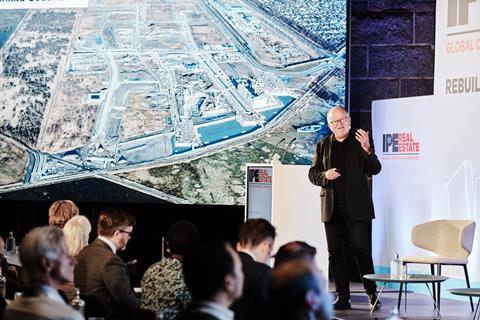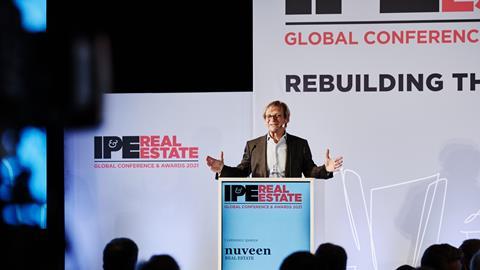Do cities still have a role to play, as centres of creativity and places for people to come together to share ideas and collaborate? The answer is yes – if last week’s IPE Real Estate Global Conference & Awards is anything to go by.
The first in-person iteration of the event since 2019 (last year’s conference was held virtually) was held in Copenhagen and attracted more than 260 pension funds, advisers and investment managers, flying in from Montreal to Milan.
It was, in fact, a hybrid event, with many more virtual delegates participating from their offices and homes. But for those there it was a reminder of how a conference based in the real world can deliver much more – conversations, connections and sharing of ideas that would have otherwise never taken place.
The new Villa Copenhagen hotel, built on the site of the old post office building in Copenhagen, was completed last year at a time when the hospitality industry had been floored by the emergence of COVID-19. The hotel was meant to be the venue of the IPE Real Estate conference in May 2020, then September 2020, and then May 2021, before finally taking place this week. Fourth time lucky.
But while there was a palpable buzz at one of the first industry conferences in a post-vaccinated Europe, the ongoing uncertainty about the future of cities and, in particular, office markets were top of the agenda – both in the conference programme, chaired as ever by Maastricht University professor Piet Eichholtz, and in the conversations outside the auditorium.
In an almost entirely mask-less Copenhagen, which recently had seen all pandemic restrictions lifted, the city felt as though it had regained pre-pandemic normality. Denmark was doing something right, it seemed.
In fact, it could be argued that Copenhagen has been doing many things right for some time. The first speaker of the day, Jens Kramer Mikkelsen, director of urban development at NREP and a former mayor of the city, told a story of transformation over two and half decades. Mikkelsen was mayor from 1989 to 2004 and then CEO of the publicly run Copenhagen City & Port Development Corporation for the subsequent 10 years, overseeing a massive regeneration of parts of the city.

During this time, industrial harbourside areas and deprived neighbourhoods in the city were transformed, while new liveable areas were built on under-utilised and reclaimed land – and only once essential transport infrastructure had been put in place.
It was a useful local case study of what could be done in a city – improving the lives of citizens while also collaborating with private capital, such as pension funds.
Paul Clark, former CIO of The Crown Estate and now head of European real estate at AustralianSuper knows a thing or two about major mixed-use agglomerations – his former employer owns significant swathes of London’s West End, while Australia’s largest superannuation fund is invested in the massive regeneration project further to the northwest in King’s Cross.
To make large mixed-use, masterplan projects a success you must have three things, he said: “control, quality and location”. AustralianSuper’s strategy in Europe remains concentrated on city centres “where we like the supply and demand”, demographics and infrastructure, and the immediate focus will be on residential and central offices in London, Clark said.
Perhaps most importantly for the industry, Clark said the disruption caused, or accelerated, by COVID-19 should not be expected to “unpick thousands of years of history” in cities like London, with its “uncurated” mixed-use areas that have “agglomerated over time”.
These sentiments were largely in response to a presentation by Brian Klinksiek, head of European research and global portfolio strategies at LaSalle Investment Management, who sought to ask what the home-working phenomenon really meant for cities and offices. Did it mean that city centres would remain in decline and be supplanted by suburban areas that can now offer everything people need? Klinkskiek questioned the viability of ‘15 Minute City’ model of urban environments being able to offer residents all essential services within a quarter of an hour’s walk or bike ride.
But the general consensus seemed to be that the future would not be decided by a competition between urbanisation and suburbanisation, but rather a new relationship. Klinksiek showed the things that only city centres can provide – activities that call for a significant coming together of people that suburbs cannot provide. LaSalle now focuses on what it terms “liveable zones” and “confluence zones” when analysing geographic markets.
Another option, of course, is to avoid offices altogether. One of the recurring themes of the conference was the shift to alternative property types, as COVID-19 appears to accelerate the move from traditional sectors – retail and office, especially – to more operational, but often demographic-led asset classes, like healthcare, student housing and various forms of residential.
Robert-Jan Foortse, head of European property investments at APG, revealed how significant this has been for some investors: the Dutch pension fund investor had 60% of its real estate portfolio in office and retail in 2013; today those sectors make up around 30%. Fellow Dutch investor MN is also in the middle of a process of building up its exposure to residential and logistics at the expense of retail and office, according to principal portfolio manager Jeroen Reijnoudt.
Justin Curlow, global head of research and strategy at AXA IM Alts, led this session and explained how his company had been focusing on alternatives underpinned by “mega-trend tailwinds” well before the onset of COVID-19, and in part as a defensive play on the assumption that there would be some form of economic downturn in the future.
But it is not just COVID-19 and changes in working patterns that cities have to contend with; climate change is the much bigger problem. And while there is an urgent need to cut emissions from buildings around the world, it is too late to focus only on “mitigation”, according to keynote speaker Parag Khanna, global strategy adviser and founder of FutureMap. “We need to build scenarios for – and invest in – adaptation,” he said. Khanna showed how “mass population relocation”, led by parts of the world becoming less habitable, would be critical to understanding the future of real estate.
In the meantime, real estate investors should still try to do what they can limit their industry’s contribution – often said to equate to 40% of emissions – to climate change. Sophie Van Oosterom, global head of real estate at Schroders Capital, led a session on carbon net zero, showing how it would be possible to achieve an 80% reduction in real estate portfolios and how the necessary retrofit costs could be offset by carbon pricing.

Existing measures of real estate sustainability can only take the industry so far, she said: energy-efficiency building certifications only showed the theoretical sustainability of building – not taking into account how tenants actually use them; and GRESB, while a very important tool, was in danger of creating a false sense of security if the industry only focused on collecting data and reporting.
The day before, a new initiative involving six Dutch pension funds and consulting firm Finance Ideas was launched at the conference, during an invitation-only roundtable for pension funds. The Green Real Estate Engagement Network has been set up to help investors pool their resources on engagement and effectively speed up progress being made by private real estate funds and listed property companies.
During van Oosterom’s panel session, Henk Groot, CIO of Pensioenfonds Detailhandel, one of the six founding pension funds of GREEN, said: “We all need to be aware it is really urgent. As an asset owner, we want to take that responsibility and urge our asset managers – not only on the real estate side but all asset classes – to really think along [with us] and collaborate.”
Asked about incentivising asset managers to be aligned with Detailhandel, Groot said: “We are in there for the long term, also in our relationship with our managers. I don’t want to [have to] incentivise them, but if they don’t work together with us and don’t see us as a strategic partner, then we have to say goodbye and work with others.”
Van Oosterom also asked Groot how the pension fund could reconcile the need to reduce emissions while maintaining the best possible returns. Groot said a survey of Detailhandel’s membership found that “our beneficiaries want us to become more green, more social” and would agree to a reduction in return if necessary. He said the evidence was there “that everybody is ready for a little bit lower return and, in return, a better world”.















